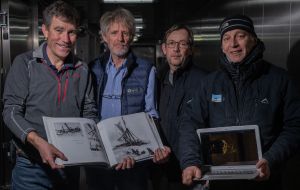MercoPress. South Atlantic News Agency
Falklands Maritime Heritage Trust and a bit of history on Eundurance22
 Mensun Bound, Director of Exploration and Simon Frederick Lighthelm, Ice pilot of the expedition raise the Falklands flag on the SA Angulhas II.
Mensun Bound, Director of Exploration and Simon Frederick Lighthelm, Ice pilot of the expedition raise the Falklands flag on the SA Angulhas II.  Mensun Bound and John Shears in the AUV control room congratulate each other when the Endurance discovery. Pic. Frédéric Bassenmayousse
Mensun Bound and John Shears in the AUV control room congratulate each other when the Endurance discovery. Pic. Frédéric Bassenmayousse  John Shears, Mensun Bound, Nico Vincnet and JC Colliers. Photo: Esther Horvath
John Shears, Mensun Bound, Nico Vincnet and JC Colliers. Photo: Esther Horvath On 5th March 2022 the Endurance22 Expedition, organized and funded by the Falklands Maritime Heritage Trust, located the wreck of Sir Ernest Shackleton’s iconic three-masted polar sailing ship, Endurance, which had not been seen since it was crushed by ice in the Weddell Sea in 1915. Among the team of Endurance 22 was Mensun Bound, a Falklands born maritime archeologist who was Director of Exploration.
On 3rd February 2022, a major international scientific expedition set sale from Cape Town to explore the Antarctic – one of the coldest, harshest and most remote locations in the world. Their mission was to find the Endurance, which hadn’t been seen for more than 100 years. Using underwater robots, helicopters and other state-of-the-art technology, the Endurance22 expedition was the first to locate and survey Sir Ernest Shackleton’s lost ship which sank in the Weddell Sea in Antarctica in 1915.
The Endurance22 expedition provided an unprecedented opportunity to explore one of the most remote and least studied places on our planet in a quest to uncover the lost secrets of the Endurance. Carrying a team of over 65 members, the mission was conducted from the South African polar research and logistics vessel, S.A. Agulhas II.
The approximate location of Endurance was logged by the ship’s captain, Frank Worsley, using a sextant and a theodolite at the spot where she eventually sank in 1915, after becoming trapped and eventually crushed by the thick sea ice of the Weddell Sea. The Endurance22 expedition team used this information to get as close as possible to the Endurance wreck site.
The Endurance22 Expedition was the first to deploy SAAB Sabertooth underwater vehicles to search for the wreck of Sir Ernest Shackleton’s lost ship, Endurance. These hybrid vehicles combine the attributes of a Remote Operating Vehicle (ROV) – always linked to the surface – and an Autonomous Underwater Vehicle (AUV) – capable of operating without such a link.
When the vessel was crushed in the ice and sank in 1915, Captain Frank Worsley took detailed measurements of the location using a sextant and recorded it in his diary, which is now in the Scott Polar Research Institute (SPRI) archives. Consequently, the expedition team knew where to focus its search efforts and where to deploy the Sabertooths under the ice, in order to locate the wreck.
The Sabertooths have the ability to reach sites up to one hundred miles away from the ship from which they are launched and to return with photos, video and survey data. This meant that even if the sea ice conditions were difficult, it could be possible for the expedition to survey the site of the wreck, even if the expedition ship S.A. Agulhas II couldn’t reach the location itself.




Top Comments
Disclaimer & comment rulesCommenting for this story is now closed.
If you have a Facebook account, become a fan and comment on our Facebook Page!